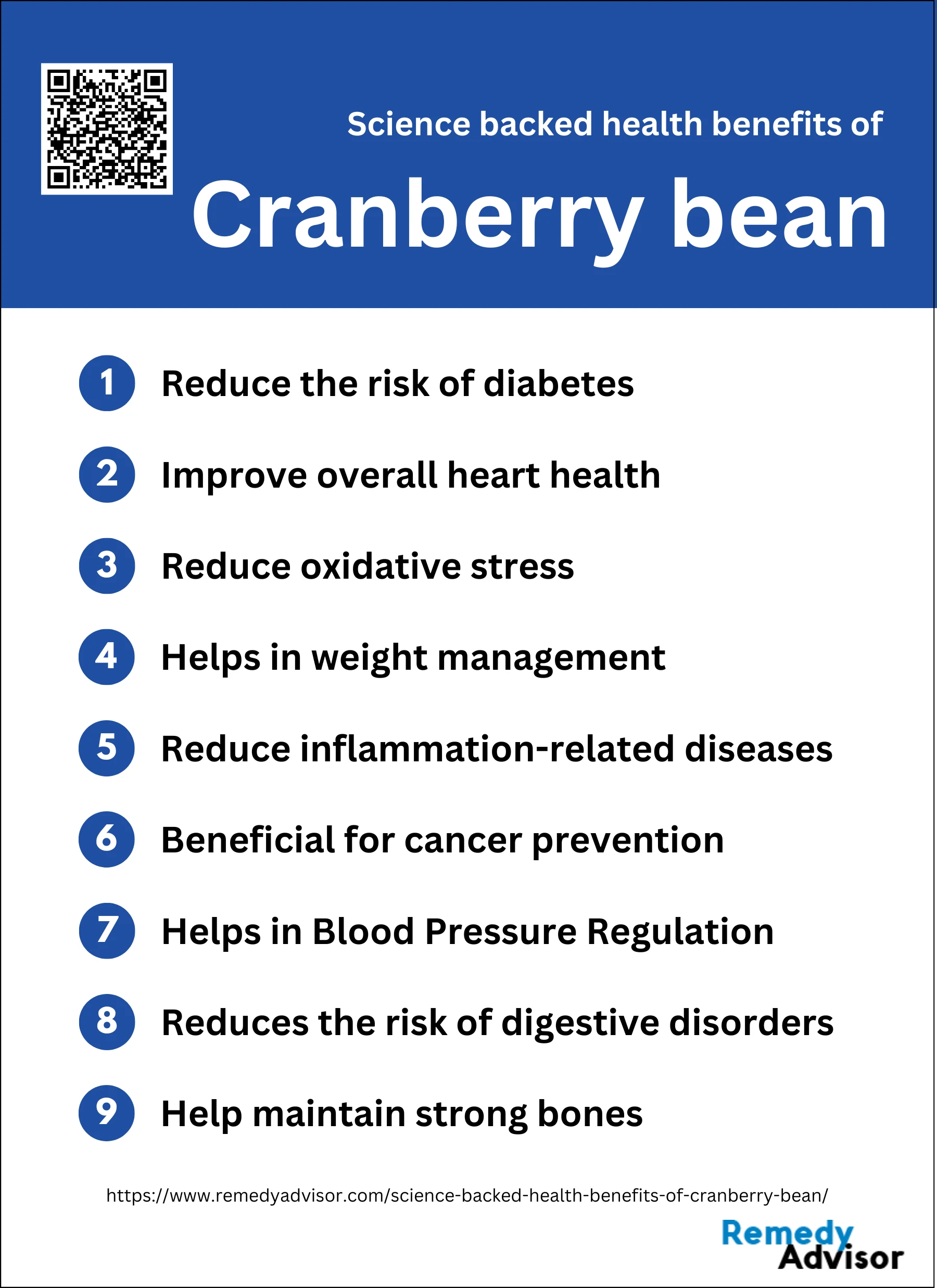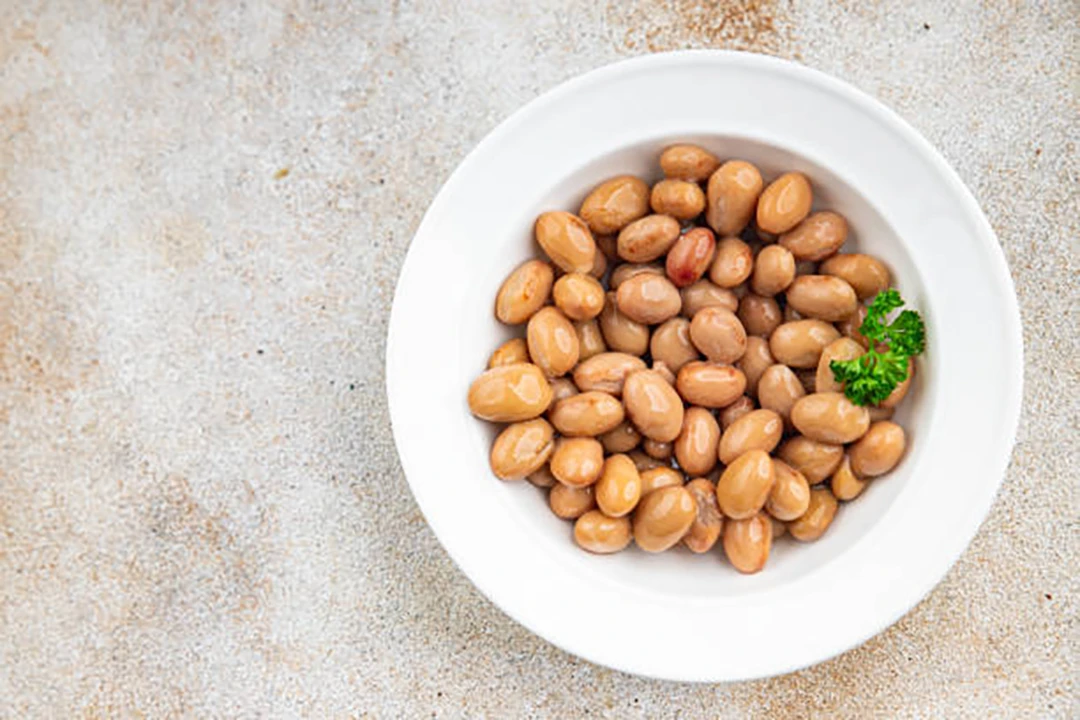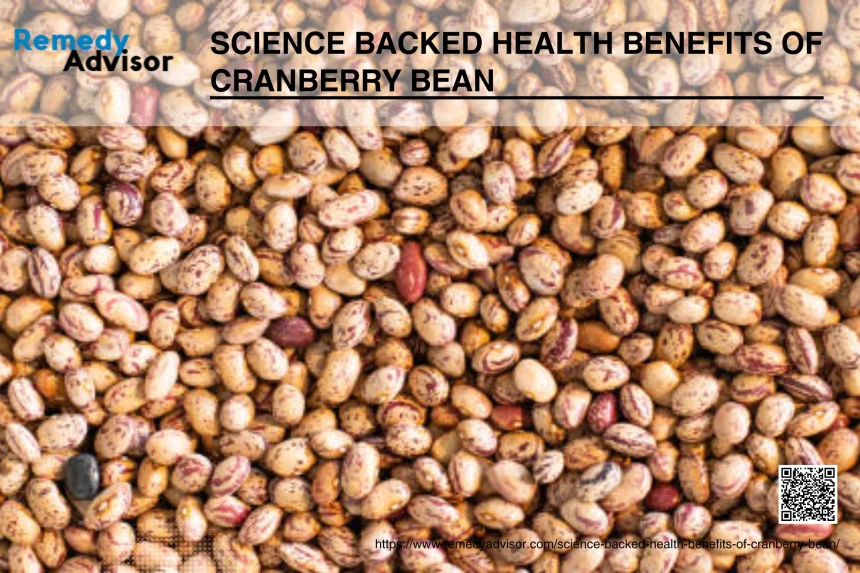Cranberry beans, also known as borlotti or Roman beans, are a nutritious legume that offers several science-backed health benefits. These speckled red and white beans are not only visually appealing but also pack a powerful nutritional punch. Rich in protein, fiber, vitamins, and minerals, cranberry beans have been associated with improved heart health, better blood sugar control, and enhanced digestive function. Their high antioxidant content, particularly polyphenols, may also provide protection against chronic diseases. In this article, we’ll explore the evidence-based health benefits of incorporating cranberry beans into your diet and how they can contribute to overall wellness.
What is Cranberry bean?
Cranberry beans are a variety of common beans known for their distinctive appearance and health benefits. These beans are characterized by their unique color patterns, which can vary between regular-darkening (RD) and non-darkening (ND) types. Cranberry beans are rich in phenolic compounds, including flavonoids and proanthocyanidins, which contribute to their high antioxidant activity. They have been shown to possess anti-inflammatory properties and can enhance gut health by altering the microbiota and reducing colitis severity. Additionally, cranberry beans have been studied for their potential in managing postprandial hyperglycemia due to their inhibitory effects on enzymes like α-glucosidase and α-amylase. The development of cranberry bean cultivars, such as the disease-resistant ‘Capri’, has further improved their agronomic traits and marketability. Overall, cranberry beans are not only a nutritious food source but also hold promise for various health applications due to their rich phytochemical profile and bioactive properties.
Nutritional Profile:
Cranberry beans boast an impressive nutritional profile, making them a valuable addition to a healthy diet. These legumes are packed with essential nutrients, offering a well-rounded combination of macronutrients and micronutrients. A one-cup serving (177g) of cooked cranberry beans provides approximately 241 calories, with a balanced distribution of carbohydrates, protein, and minimal fat. This nutrient-dense food is particularly rich in dietary fiber, folate, and various minerals, contributing to its reputation as a nutritious and versatile ingredient in many cuisines.
Detailed breakdown of macronutrients:
The macronutrient composition of cranberry beans is well-balanced, with a focus on complex carbohydrates and plant-based protein. A one-cup serving (177g) of cooked cranberry beans contains about 43.3g of carbohydrates, 16.5g of protein, and only 0.81g of fat. This distribution makes cranberry beans an excellent choice for those seeking a low-fat, high-fiber food source. The carbohydrates in cranberry beans are primarily complex carbohydrates, which provide sustained energy and contribute to feelings of fullness.
Protein content and its benefits:
Cranberry beans are an excellent source of plant-based protein, containing approximately 16.5g per one-cup serving (177g) of cooked beans. This high protein content makes them particularly valuable for vegetarians, vegans, and those looking to increase their plant-based protein intake. The protein in cranberry beans is complete, meaning it contains all nine essential amino acids required by the human body. This protein content supports muscle growth and repair, aids in enzyme and hormone production, and contributes to overall body function and maintenance.
Carbohydrates, including fiber content:

Cranberry beans are rich in complex carbohydrates, with a one-cup serving (177g) of cooked beans providing about 43.3g of total carbohydrates. A significant portion of these carbohydrates comes from dietary fiber, with 15.2g per serving, which is approximately 54% of the daily recommended value. This high fiber content offers numerous health benefits, including improved digestive health, better blood sugar control, and increased feelings of fullness, which can aid in weight management. The complex carbohydrates in cranberry beans also provide a steady source of energy, making them an excellent choice for sustained physical and mental performance.
Healthy fats present in cranberry beans:
While cranberry beans are not a significant source of fat, they do contain small amounts of healthy fats. A one-cup serving (177g) of cooked cranberry beans contains only 0.81g of total fat. Of this, a portion consists of beneficial polyunsaturated and monounsaturated fats, including omega-3 and omega-6 fatty acids. Although the fat content is minimal, these healthy fats contribute to the overall nutritional value of cranberry beans and play a role in nutrient absorption and hormone production.
Micronutrients and their roles:
Cranberry beans are rich in various micronutrients that play crucial roles in maintaining overall health. These beans are particularly high in folate (vitamin B9), providing about 25% of the daily recommended intake per serving. Folate is essential for DNA synthesis, cell division, and preventing certain birth defects. Other notable micronutrients in cranberry beans include iron, which is vital for oxygen transport in the blood; magnesium, important for muscle and nerve function; and potassium, which helps regulate blood pressure and supports heart health.
Vitamins (e.g., B vitamins, vitamin C):
Cranberry beans are an excellent source of several B-complex vitamins. They are particularly rich in folate (vitamin B9), providing about 100 micrograms or 25% of the daily intake per cup of cooked beans. Other B vitamins present in significant amounts include thiamin (vitamin B1), which is crucial for energy metabolism, and vitamin B6, important for brain development and function. While not a primary source, cranberry beans also contain small amounts of vitamin C, which supports immune function and acts as an antioxidant.
Minerals (e.g., iron, magnesium, potassium):
Cranberry beans are a rich source of essential minerals. They provide significant amounts of iron, with about 3.7mg per cup of cooked beans, which is approximately 21% of the daily recommended intake. This makes them valuable for preventing iron-deficiency anemia. Magnesium is another mineral found in abundance, with 88.5mg per cup, supporting muscle and nerve function. Potassium is present in substantial quantities, offering about 685mg per cup, which is 15% of the daily value. This mineral is crucial for heart health and blood pressure regulation. Additionally, cranberry beans contain zinc, copper, and phosphorus, all of which contribute to various bodily functions and overall health.
Science backed health benefits of Cranberry bean
Cranberry beans are not just a colorful addition to your plate; they are a powerhouse of nutrition with numerous health benefits backed by science. These beans are packed with essential nutrients such as protein, fiber, vitamins, and minerals, making them a valuable component of a balanced diet. From improving heart health and aiding in weight management to enhancing digestive function and regulating blood sugar levels, cranberry beans offer a wide array of health advantages. In this article, we delve into the science-backed health benefits of cranberry beans, highlighting why they deserve a spot in your pantry.

1. Reduce the risk of diabetes
Beans are a powerful ally in reducing the risk of diabetes due to their rich nutritional profile and low glycemic index (GI). High in dietary fiber and protein, beans help stabilize blood sugar levels by slowing down the digestion and absorption of carbohydrates, preventing rapid spikes in blood glucose. This makes them an excellent food choice for managing diabetes and potentially lowering the risk of developing the condition. Studies have shown that incorporating beans into the diet can improve blood glucose control, reduce blood pressure, and lower cholesterol levels, all of which are crucial for diabetes management and overall cardiovascular health. Additionally, beans are nutrient-dense, providing essential vitamins and minerals like magnesium and potassium, which further support metabolic health and insulin sensitivity.
What Research Says?
- Consumption of beans, such as the ‘Almonga’ and ‘Curruquilla’ varieties, significantly reduces postprandial glucose and insulin levels compared to bread.
- Beans contain bioactive compounds like saponins, which have anti-inflammatory and anti-diabetic effects, potentially reducing the risk of diabetic complications.
- White common bean extract (WCBE) improves glucose metabolism and reduces diabetic complications, possibly through the modulation of gut microbiota.
- Study shows that beans can lower LDL cholesterol and the risk of heart disease. But their impact on diabetes isn’t as clear. Some research suggests beans might lower blood sugar after meals, but the results vary a lot between studies.
2. Improve overall heart health

Rich in soluble fiber, beans help lower LDL (bad) cholesterol levels and reduce blood pressure, two key risk factors for cardiovascular disease. Their high content of plant-based protein, combined with a low glycemic index, aids in weight management and blood sugar control, both crucial for heart health. Beans are also packed with heart-healthy minerals like potassium and magnesium, which support proper heart function and blood pressure regulation. Additionally, the antioxidants and phytochemicals found in beans, such as flavonoids and polyphenols, help combat inflammation and oxidative stress, further protecting the cardiovascular system. Regular consumption of beans as part of a balanced diet has been associated with a reduced risk of coronary heart disease, stroke, and overall cardiovascular mortality.
What Research Says?
- Studies show that beans can lower LDL cholesterol and the risk of heart disease. But their impact on diabetes isn’t as clear. Some research suggests beans might lower blood sugar after meals, but the results vary a lot between studies.
- Eating beans regularly can lower your chance of heart diseases, like heart attacks and coronary heart disease.
- Darker beans, like black and red kidney beans, help blood vessels work better. They relax the vessels and lower blood pressure, which is good for the heart.
- Eating beans can help with weight control, lead to a lower body weight, and result in a smaller waist size. These are key in cutting down the risk of heart disease.
- Beans are full of nutrients and antioxidants that help protect the heart. They have fiber, potassium, magnesium, and polyphenols. These can lower stress and inflammation in the body.
3. Reduce oxidative stress
Beans offers a robust defense mechanism through their rich antioxidant content. Various types of beans, including black, red kidney, pinto, and small red beans, have been shown to possess exceptionally high antioxidant activity, with some varieties containing more antioxidants than many fruits and vegetables. The antioxidants in beans, particularly polyphenols and flavonoids, help neutralize harmful free radicals in the body, thereby reducing oxidative damage to cells and tissues. Studies have demonstrated that consuming beans can attenuate postprandial oxidative stress, with one investigation revealing that black beans in a meal led to a decrease in oxidized LDL cholesterol. Furthermore, the antioxidant properties of beans extend beyond their raw state, as even cooked beans maintain significant antioxidant activity.
What Research Says?
- Beans, especially black beans and common beans, are rich in polyphenols, which have potent antioxidant properties that help reduce oxidative stress and prevent degenerative diseases.
- Beans are full of nutrients and antioxidants that help protect the heart. They have fiber, potassium, magnesium, and polyphenols. These can lower stress and inflammation in the body.
- Eating black beans and other beans full of polyphenols greatly lowers markers of oxidative stress. These include substances like malondialdehyde (MDA) and oxidized LDL (oxLDL). It also boosts antioxidant levels in the blood.
- Beans have helped animals fight liver damage and stress from high-fat diets. This shows they might help manage high blood fat levels and related stress.
- Beans are high in polyphenols, which boost our body’s natural defense against oxidation. They work through pathways like PI3K/Akt/Nrf2/HO-1.
4. Helps in weight management
Beans are an excellent food for weight management due to their high fiber and protein content, which help increase satiety and reduce overall calorie intake. The fiber in beans slows digestion, keeping you fuller for longer and preventing overeating. Additionally, beans have a low glycemic index, which helps stabilize blood sugar levels and reduce cravings for high-calorie snacks. Incorporating beans into your diet can lead to significant weight loss and reductions in body fat and waist circumference. Moreover, beans are low in fat and calories, making them an ideal substitute for higher-calorie foods like meat and dairy, further aiding in weight management.
What Research Says?
- Bean consumers tend to have lower body weight and smaller waist circumferences compared to non-consumers.
- Beans enhance lipid metabolism by increasing the oxidation of long-chain fatty acids and reducing circulating triglycerides.
- Bean consumption can reduce inflammation markers in adipose tissue, contributing to better weight management and metabolic health.
- Diets high in fiber and beans work as well as low-carb diets for losing weight. They also help lower harmful lipids.
5. Reduce inflammation-related diseases

Beans have emerged as powerful allies in the fight against inflammation-related diseases due to their unique nutritional profile and bioactive compounds. Rich in fiber, protein, and various phytonutrients, beans have been shown to possess significant anti-inflammatory properties that can help reduce the risk of chronic diseases such as heart disease, diabetes, and certain cancers. Studies have demonstrated that regular consumption of beans can lower markers of inflammation in the body, including C-reactive protein (CRP) and interleukin-6 (IL-6). The antioxidants and anti-inflammatory compounds found in beans, such as polyphenols, flavonoids, and saponins, work synergistically to combat oxidative stress and modulate inflammatory pathways. Furthermore, the high fiber content in beans supports gut health by promoting beneficial bacteria, which in turn can reduce systemic inflammation.
What Research Says?
- Eating different beans (like white, dark kidney, cranberry, navy, and black beans) can help lessen the effects of colitis. They can reduce damage in the colon and lower levels of inflammation-causing proteins in mice with colitis caused by dextran sodium sulfate (DSS).
- Bean diets increased the expression of genes promoting gut barrier integrity and antimicrobial defense, such as MUC1, Relmβ, and TFF3, and reduced the expression of pro-inflammatory mediators like IL-1β, IL-6, IFNγ, and TNFα.
- Extracts rich in phenolics from beans like white kidney and round purple beans showed strong antioxidant and anti-inflammatory effects. They did this by lowering NO production and cytokine mRNA levels in macrophages treated with LPS.
- Dry common beans rich in polyphenols have health benefits. They can reduce inflammation, act as antioxidants, and help prevent diabetes, obesity, and cancer.
6. Beneficial for cancer prevention
Beans are beneficial for cancer prevention due to their rich content of fiber, antioxidants, and bioactive compounds. Studies have shown that beans, particularly navy and black beans, can enhance gut health and regulate immune and inflammatory processes, which are crucial for reducing the risk of colorectal cancer. The high fiber content in beans helps lower the risk of colorectal and breast cancers by promoting healthy digestion and reducing inflammation. Additionally, beans contain phytochemicals such as flavonoids and polyphenols, which have been shown to inhibit tumor growth and induce apoptosis in cancer cells. Regular consumption of beans as part of a balanced diet can thus play a significant role in cancer prevention by supporting overall metabolic health and reducing oxidative stress.
What Research Says?
- Eating black beans and navy beans greatly reduced the number of colon tumors in rats. This is because the beans helped control hunger, cut down body fat, and increased butyrate levels in the colon.
- Eating more rice bran and navy beans improved the variety of gut bacteria. It also changed body chemicals in blood, pee, and poop. These changes are linked to slower growth of colorectal cancer cells.
- Common beans, like adzuki beans and black soybeans, showed strong abilities to stop the growth of different cancer cells. They also caused cell death, maybe by changing how genes interact with nutrients and how proteins are made.
- People who eat a lot of legumes, like beans, seem to have a lower chance of getting cancer. Studies and reviews show that beans might slow down tumor cells and the growth of polyps. But we need more clear-cut studies to be sure of these results.
- Mung beans have healthy plant chemicals. They can help control metabolism, lower swelling, and stop cell growth that may lead to cancer. They also have antioxidant qualities that can prevent cancer.
7. Helps in Blood Pressure Regulation

Beans play a significant role in blood pressure regulation due to their rich nutritional profile. They are an excellent source of potassium, magnesium, and fiber, all of which contribute to maintaining healthy blood pressure levels. Potassium, in particular, helps counteract the effects of sodium and relaxes blood vessel walls, leading to lower blood pressure. The high fiber content in beans also aids in reducing cholesterol levels, which is closely linked to hypertension. Regular consumption of legumes, including beans, is associated with a lower risk of developing hypertension. For instance, research indicates that consuming about 1/2 cup of cooked dry beans or peas daily can lead to lower odds of elevated blood pressure and a 1.7 mm/Hg reduction in mean systolic blood pressure compared to non-consumers.
What Research Says?
- Fermented beans containing γ-aminobutyric acid (GABA) and nattokinase significantly reduce systolic and diastolic blood pressure in hypertensive rats.
- Chlorogenic acid, a polyphenolic compound found in coffee beans, has been shown to reduce blood pressure in humans, particularly when hydroxyhydroquinone (HHQ) is removed from the coffee.
- Consumption of dark-colored beans like black beans and red kidney beans leads to lower blood pressure and improved vascular function in healthy adults.
- Regular consumption of black beans enhances vascular compliance and reduces blood pressure in hypertensive rats, although these benefits are lost if consumption is halted.
- Winged bean seed hydrolysate has shown significant blood pressure-lowering effects in hypertensive rats, indicating its potential as a functional food ingredient for blood pressure management.
8. Reduces the risk of digestive disorders
Beans play a significant role in reducing the risk of digestive disorders due to their high fiber content and prebiotic properties. The insoluble fiber in beans adds bulk to stools, promoting regular bowel movements and reducing the risk of constipation. Additionally, the soluble fiber in beans acts as a prebiotic, feeding beneficial gut bacteria and promoting a healthy gut microbiome. This improved gut health can help prevent various digestive issues, including inflammatory bowel diseases and diverticulitis. Furthermore, the resistant starch found in beans undergoes fermentation in the colon, producing short-chain fatty acids that have anti-inflammatory effects on the digestive tract. Regular consumption of beans has been linked to improved gut function, reduced inflammation, and enhanced digestive health overall.
What Research Says?
- Bean consumption increases the production of short-chain fatty acids (SCFAs) like acetate, butyrate, and propionate, which are beneficial for gut health.
- Eating beans helps change the bacteria in your gut. It boosts good bacteria like Prevotellaceae and Bifidobacterium. At the same time, it lowers bad bacteria such as Clostridium perfringens and Ruminococcus gnavus.
- Eating beans often can lower the risk of heart disease, diabetes, and other health issues. This is because beans have a low glycemic index and are high in fiber.
- Eating more beans, like navy beans and rice bran, can lower the risk of colorectal cancer. It helps by making gut bacteria varied and plentiful and by slowing down the growth of cancer cells in the colon.
9. Help maintain strong bones
Beans contribute significantly to maintaining strong bones due to their rich content of essential nutrients such as calcium, magnesium, and phosphorus. These minerals are crucial for bone formation and maintenance. Additionally, beans contain phytates, which, despite their reputation as mineral absorption inhibitors, have been shown to have protective effects against bone loss and osteoporosis. Individuals who consume high-phytate foods, like beans, tend to have stronger bones and a lower risk of fractures compared to those who avoid these foods. Beans also provide a good source of plant-based protein, which is vital for bone health as it helps in the repair and rebuilding of bone tissue. Furthermore, the fiber in beans supports a healthy gut microbiome, which can enhance nutrient absorption, including calcium, thereby promoting better bone health.
What Research Says?
- Soybeans contain isoflavones, which have weak estrogenic properties and may help reduce the risk of osteoporosis by increasing bone mineral density.
- Yellow and black soybeans, along with sword beans, greatly boosted bone density and mineral content in rats without ovaries.
- Eating beans like soybeans, mung beans, cowpeas, and adzuki beans helped improve bone health markers in rats without ovaries. It increased osteocalcin and lowered markers that break down bone.
Ways to Include Cranberry Beans in Your Diet

Cranberry beans are a versatile and nutritious addition to any diet. Whether you’re looking to boost your protein intake, add more fiber to your meals, or simply enjoy a new ingredient, these beans can be incorporated into a variety of dishes. From hearty soups and stews to fresh salads and savory pasta dishes, cranberry beans offer endless culinary possibilities. They can even be mashed into spreads, baked into comforting casseroles, or used as a filling for stuffed vegetables. Ready to explore the delicious ways to include cranberry beans in your diet? Here are some creative ideas to get you started.
Salads
Cranberry beans can be a delightful addition to salads. Their creamy texture and nutty flavor complement fresh vegetables and vinaigrettes. Simply cook the beans until tender, then toss them with mixed greens, cherry tomatoes, cucumbers, and a light balsamic dressing. For added protein, consider adding grilled chicken or tofu.
Soups and Stews
Cranberry beans are perfect for hearty soups and stews. Their rich, creamy texture thickens the broth, making it more satisfying. Try adding them to a minestrone or a vegetable stew. Cook the beans with garlic, onions, carrots, and celery, then add tomatoes, spinach, and vegetable broth for a nutritious meal.
Pasta Dishes
Incorporate cranberry beans into pasta dishes for an extra boost of protein and fiber. They pair well with tomato-based sauces and greens. For a simple yet delicious meal, sauté garlic and onions in olive oil, add cooked cranberry beans, diced tomatoes, and spinach, then toss with your favorite pasta.
Bean Spreads and Dips
Cranberry beans can be mashed into spreads and dips, similar to hummus. Blend cooked beans with olive oil, garlic, lemon juice, and your favorite herbs for a creamy dip. This spread can be used on sandwiches, as a dip for vegetables, or as a topping for crackers.
Side Dishes
Serve cranberry beans as a simple side dish. Cook the beans with garlic, thyme, and a splash of olive oil, then season with salt and pepper. This makes a great accompaniment to grilled meats, roasted vegetables, or a fresh salad.
Bean Bowls
Create a nutritious bean bowl by combining cranberry beans with grains like quinoa or brown rice, and a variety of vegetables. Top with a tangy dressing or a dollop of guacamole for a balanced and satisfying meal. This is a versatile dish that can be customized with your favorite ingredients.
Baked Beans
For a comforting dish, try making baked cranberry beans. Cook the beans with molasses, mustard, and a touch of brown sugar, then bake until the flavors meld together. This dish is perfect for barbecues or as a cozy side during the colder months.
Stuffed Vegetables
Use cranberry beans as a filling for stuffed vegetables like bell peppers or zucchini. Mix the beans with cooked rice, tomatoes, onions, and spices, then stuff the mixture into hollowed-out vegetables and bake until tender. This makes for a colorful and nutritious meal.
Breakfast
Incorporate cranberry beans into your breakfast routine. They can be added to a savory breakfast bowl with eggs, avocado, and sautéed greens, or used in a breakfast burrito with scrambled eggs, cheese, and salsa. This adds a hearty and nutritious element to your morning meal.
Casseroles
Cranberry beans can be used in casseroles for a filling and wholesome dish. Combine cooked beans with vegetables, cheese, and a creamy sauce, then bake until bubbly and golden. This is a great way to use up leftover beans and create a comforting meal for the whole family.
Side Effects of Eating Cranberry Beans
Cranberry beans are a nutritious and delicious addition to many meals, but like any food, they come with potential side effects that are important to consider. While they offer numerous health benefits, consuming cranberry beans can sometimes lead to digestive issues, allergic reactions, and other health concerns. For individuals with specific conditions, such as kidney stones or gout, these beans might pose additional risks. Understanding these side effects can help you enjoy cranberry beans safely and make informed dietary choices. Here are some key side effects of eating cranberry beans that you should be aware of.
Digestive Issues
Cranberry beans are rich in fiber and oligosaccharides, which can be difficult for some people to digest. This can lead to bloating, gas, and diarrhea, particularly in individuals with sensitive stomachs or digestive systems. Consuming these beans in moderation and gradually increasing intake can help mitigate these effects.
Kidney Stones

Cranberry beans contain oxalates, compounds that can bind with calcium to form crystals, potentially leading to kidney stones. Individuals with a history of kidney stones should be cautious and may want to limit their intake of cranberry beans to avoid exacerbating this condition.
Allergic Reactions
Although rare, some people may experience allergic reactions to cranberry beans. Symptoms can range from mild to severe and include itching, swelling, hives, breathing difficulties, abdominal pain, nausea, and vomiting. These reactions are typically due to proteins called lectins found in the beans.
Purine Content
Cranberry beans contain purines, which can be problematic for individuals with gout or other conditions related to uric acid buildup. High levels of purines can trigger gout attacks and worsen symptoms, so those affected should monitor their intake of these beans.
Toxicity in Raw Form
Raw or undercooked cranberry beans contain toxins like phenolic acids, which can be harmful. Proper cooking destroys these toxins, making the beans safe to eat. It’s crucial to ensure that cranberry beans are thoroughly cooked before consumption to avoid potential toxicity.
Conclusion
In conclusion, cranberry beans are a nutritional powerhouse that offer numerous health benefits backed by scientific research. These versatile legumes are rich in protein, fiber, vitamins, and minerals, making them an excellent addition to a balanced diet. From reducing the risk of diabetes and heart disease to aiding in weight management and promoting digestive health, cranberry beans contribute significantly to overall well-being. Their antioxidant properties help combat oxidative stress and inflammation, while their low glycemic index supports blood sugar regulation. However, it’s important to be aware of potential side effects, particularly for those with specific health conditions or sensitivities. By incorporating cranberry beans into various dishes and cooking them properly, you can harness their nutritional benefits and enjoy their unique flavor and texture. As with any dietary change, it’s advisable to introduce cranberry beans gradually and consult with a healthcare professional if you have any concerns.
ADDITIONAL RESOURCES
Here are some notable US organizations involved in research on beans and seeds:
1. US Dry Bean Council (USDBC)
The USDBC is a private trade association promoting the U.S. edible bean trade both domestically and internationally. It collaborates with public health organizations, research centers, universities, and the entire supply chain to educate consumers about the benefits of beans.
Based in Tucson, Arizona, Native Seeds/SEARCH focuses on conserving and promoting arid-adapted crop diversity in the southwestern United States. It supports community seed grants, native access, and various seed conservation programs.
3. USDA-ARS Germplasm Resources Information Network (GRIN)
GRIN provides information about USDA’s national collections of plant, animal, and microbial genetic resources essential for food and agricultural production. It supports agricultural production by acquiring, conserving, evaluating, documenting, and distributing crop germplasm.
4. USA Pulses
This organization promotes pulses, including dry peas, beans, lentils, and chickpeas, for their nutritional benefits. They provide resources for cooking with pulses, health and nutrition information, and support for the pulse industry.
Recommendations for books on cranberry beans
Here are a few recommendations for books on the research of cranberry beans:
1. “Dry Beans and Pulses Production, Processing, and Nutrition“
This comprehensive book covers various aspects of dry beans, including cranberry beans, focusing on their production, processing, and nutritional benefits.
2. “Legumes: Importance and Constraints“
This book highlights the significance of legumes, including cranberry beans, in agriculture and human nutrition, discussing their health benefits and the challenges in their production.
3. “Grain Legumes“
This book provides detailed information on grain legumes, including cranberry beans, covering aspects such as their cultivation, health benefits, and research findings.
FAQS
- What are the main nutritional benefits of cranberry beans?
Cranberry beans are rich in protein, fiber, complex carbohydrates, and various vitamins and minerals. They are particularly high in folate, magnesium, potassium, and iron. - How do cranberry beans impact heart health?
Studies suggest that cranberry beans may help manage cholesterol levels and reduce the risk of cardiovascular diseases by lowering inflammatory markers and improving blood glucose regulation. - Can cranberry beans help with weight management?
Yes, cranberry beans are low in calories and high in fiber, which can promote satiety and potentially aid in weight management. - Do cranberry beans have any anti-cancer properties?
Research indicates that compounds in cranberry beans may have positive effects on cancer cells, potentially reducing inflammation and slowing the growth of cancer cells. - How do cranberry beans affect blood sugar levels?
Cranberry beans have a low glycemic index, which means they release glucose slowly into the bloodstream, potentially helping to manage or prevent diabetes. - Are there any benefits for digestive health?
The high fiber content in cranberry beans can improve bowel movements and may help with issues like constipation. - Do cranberry beans have anti-inflammatory properties?
Yes, studies have shown that phenolic-rich extracts from cranberry beans can have anti-inflammatory effects, particularly in the intestines. - Can cranberry beans help with anemia prevention?
Cranberry beans are rich in iron and copper, which are essential for red blood cell formation and oxygen transport in the body. - Are there any skin health benefits associated with cranberry beans?
Cranberry beans are rich in vitamin C, which may help stimulate collagen synthesis and protect against UV-induced photodamage. - How do cranberry beans impact gut microbiota?
Research suggests that diets enriched with cranberry beans can alter the gut microbiota in beneficial ways, potentially mitigating colitis severity and associated inflammation.







